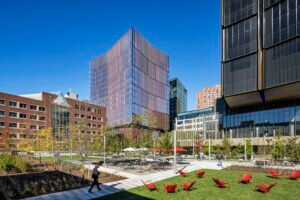MIT’s School of Architecture and Planning (SA+P) has scouted a potential new home in the Metropolitan Storage Warehouse, which will expand SA+P’s programs and establish the Institute as a design hub.
The proposed move to the landmark building is a push to create a hub for design research and education while allowing the expansion of activities and new public spaces, according to Hashim Sarkis, dean of SA+P.
“It’s about really creating a design hub for MIT on the campus, bringing the expanding and increasingly important areas of design from across MIT—art, architecture, and urban planning—together in one place,” Sarkis said in MIT News. “Moving does not address just the school’s aspirations, but MIT’s aspirations.”
A feature of the proposed move is a new maker space, providing expanded design and fabrication facilities and allowing Institute researchers to collaborate (physically and virtually) with the MIT Hong Kong Innovation node. Other features include an expansion of classroom and design studio space, an increase in exhibition capacity for arts and design programming, a new center for the arts, new areas for collaboration-based work, and ground-floor retail space.
SA+P is becoming more involved with cross-disciplinary collaborations, including a recent announcement of a new undergraduate major that combines a bachelor of science in urban science and planning with computer science. Redeveloping the Metropolitan Storage Warehouse to accommodate SA+P while facilitating interdisciplinary interactions would be “transformational,” according to Sarkis.
The renovation of the Metropolitan Storage Warehouse, which was designed by Peabody and Stearns and began construction in 1894, would be necessary before any move is made. It is one of the oldest buildings on MIT’s campus and is listed on the National Register of Historic Places, however, and would require approval from the City of Cambridge before any changes are made.











